Lindenbaum Platform Integration
Learn how to build your Lindenbaum Cognitive Voice bot with the Jovo Framework.
Getting Started
Tutorial: Build IVRs with Lindenbaum Cognitive Voice and Jovo.
Lindenbaum Cognitive Voice is a European platform to create voice bots that are deployable as smart IVR systems. The platform offers the possibility to choose from a wide stack of NLUs, TTS, and STT engines as well as integrations for multiple European contact center platforms. Learn more in the official Lindenbaum API documentation.
The Jovo Lindenbaum integration covers both the platform's Core and Dialog API to handle incoming requests and send out the correct responses.
Installation
First, you have to install the npm package:
After that, initialize it in your project the following way:
Besides that, you have to add an NLU. Jovo provides integrations for a big variety of NLUs from Dialogflow to Rasa and more.
The NLU has to be added as a plugin to the platform:
The Lindenbaum platform sends requests to three separate endpoints. The ExpressJS server of a default Jovo project only supports one endpoint. Because of that, we add a middleware which redirects all of the 3 endpoints to the single default one. The integration already provides the necessary middleware function. You simply have to import and it to your project's ExpressJs instance.
For that, add the following piece of code to your project's index.js file:
Basics
All of the Lindenbaum specific objects and functions are accessed using the $lindenbaumBot object:
The object will only be defined if the incoming request is from Autopilot. Because of that, you should first check whether it's defined or not before accessing it:
User ID
The Lindenbaum platform does not offer a distinct user ID. The reason being that the only identifier for each user (their phone number) is not always present, for example through anonymous calls.
Because of that, we use the session ID as the user ID at the same time.
Requests
As described earlier, the Lindenbaum platform sends requests to four different endpoints. Each endpoint has a different request schema.
The first request is sent to the /session endpoint when the user calls the bot's number. It is automatically mapped to Jovo's LAUNCH intent and has the following scheme:
The second endpoint, /message, receives the requests containing the user's input (either speech or DTMF). It is always handled as an intent, with the NLU determining which intent to route to.
Third, the /terminated endpoint which receives the request that is sent when the user ends the call. It is automatically routed to the END intent:
Last but not least, the /inactivity endpoint which receives a request after the user hasn't responded for X seconds. The request is automatically routed to the ON_INACTIVITY intent:
Since the Lindenbaum platform doesn't use an NLU, it also doesn't parse any kind of NLU data with its requests (intent, inputs). That means some of the functions like this.$request.getIntentName() don't work. In that case, the framework will put out a warning and tell you how to access the data correctly.
ON_DTMF
The platform allows the user to use the phone's keypad. In that case you receive a intent request with the type property set to DTMF and the text property being the pressed button:
These requests are automatically routed to the ON_DTMF intent:
$request
For the $request object it means, that not all properties are defined at all times. Only dialogId and timestamp are.
Here's the complete interface of the class:
| Name | Description | Value |
|---|---|---|
callback |
the base URL which will be used to send out the response | string |
confidence |
describes how confident the platform is with the ASR | number - 0 <= x <= 100 |
dialogId |
the id that is used as both session ID and user ID | string |
language |
the locale of the incoming request, e.g. en-US |
string |
local |
the phone number of the bot | string |
remote |
the phone number of the caller. Could be undefined if it's an anonymous call | string |
text |
the user's input | string |
timestamp |
the timestamp of the request in UNIX time | number |
type |
the type of input. Either SPEECH or DTMF |
enum |
Besides that the integration offers you the following getters/setters (depending on the request, some getters might return undefined):
| Name | Description | Return Value |
|---|---|---|
getCallbackUrl() |
returns the callback property |
string or undefined |
getLocal() |
returns the local property |
string or undefined |
getLocale() |
returns the language property |
string or undefined |
getMessageType() |
returns the type property |
string or undefined |
getRawText() |
returns the text input. | string |
getRemote() |
returns the remote property |
string or undefined |
getSessionId() |
returns the dialogId |
string |
getTimestamp() |
returns timestamp in ISO 8601 format | string |
getUserId() |
returns the dialogId, see User ID for explanation |
string |
setCallbackUrl(url: string) |
sets the callback property |
LindenbaumRequest (i.e. $request) |
setLocal(phoneNumber: string) |
sets the local property |
LindenbaumRequest |
setLocale(locale: string) |
sets the language property |
LindenbaumRequest |
setMessageType(type: 'SPEECH' | 'DTMF') |
sets the type property |
LindenbaumRequest |
setRawText(text: string) |
sets the text property |
LindenbaumRequest |
setRemote(phoneNumber: string) |
sets the remote property |
LindenbaumRequest |
setSessionId(id: string) |
sets the dialogId property |
LindenbaumRequest |
setTimestamp(timestamp: string) |
sets the timestamp property. Parameter has to be ISO 8601 format |
LindenbaumRequest |
setUserId(id: string) |
sets the dialogId property |
LindenbaumRequest |
Responses
The Lindenbaum platform doesn't follow the usual JSON response path. Although you do receive requests, you don't send out one single response, but call multiple API endpoints for each type of response (e.g. speech output, audio, etc.).
While that is different from what you're probably used to, it allows you to create more creative responses, for example, first the speech output then an audio file followed by another speech output. That wouldn't be possible with Alexa.
The following responses are supported:
| Function | Description | Return Value | Endpoint |
|---|---|---|---|
addBridge(extensionLength: number, headNumber: string) |
bridge the call to the headNumber parameter |
this | /call/bridge |
addData(key: string, value: string) |
add data to the current conversation. Can be later on retrieved using the Lindenbaum Dialog API | this | /call/data |
addDrop() |
terminate the conversation manually | this | /call/drop |
addForward(destinationNumber: string) |
forward the call to the destinationNumber parameter |
this | /call/forward |
tell(text: string) / ask(text: string) |
standard speech output. If you use drop, the framework will also add an API call to the /call/drop endpoint at the end to terminate the conversation |
this | /call/say |
If you add a call to the bridge or forward endpoint and want to add additional speech output, you have to use ask(). The tell() function automatically adds a call to the drop endpoint which terminates the whole session and with that blocks bridge and forward.
Since the Jovo Framework was first built for Alexa & Google Assistant, it is not perfectly fit to accommodate the wide range of response possibilities. One such limitation would be, that the Jovo Framework only allows a single speech output per response. If you want to create more complex responses, we allow you to set the response yourself using the setResponses(responses: Responses[]) function:
Here are the interfaces for each of the responses (you can also import these if you're using typescript):
Order of the Responses
Since we send out multiple API calls with each request & response cycle, the order in which these API calls are made is important.
If you use the setResponses() function we follow the principle of what you see is what you get, meaning the API calls will be made in the order of the array, starting from index 0 and ending with n - 1.
For more simple responses using the Jovo built-in functions, e.g. tell() or ask() as well as Lindenbaum function, e.g. addForward(), addBridge(), etc., we have the following order data -> ask/tell -> forward/bridge
Dialog API
Using the Dialog API you can retrieve data about the session for up to 10 minutes after it is finished. Besides a complete transcription of the session, you can also add your own data using the /call/data endpoint.
Using the getDialogData(resellerToken: string, dialogId?: string) method you can retrieve the data from the Dialog API. If you don't parse the dialogId, the framework will use the current request's id.
If the API request was successful, you will receive a response with the following properties:
| Name | Description | Value |
|---|---|---|
dialogId |
the dialogId to which the data belongs to |
string |
callId |
the call ID | string |
data |
an array of objects representing the complete session | object[] |
You can also delete saved data using the deleteDialogData(resellerToken: string, dialogId?: string) method:






